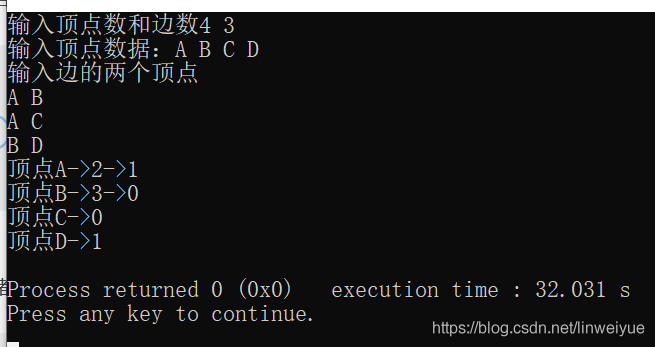C语言邻接表表示法创建无向图并输出
2020-07-21 04:12
2521 查看
C语言邻接表表示法创建无向图并输出
邻接表是图的一种链式存储结构,对图的每个顶点建立一个单链表,单链表第一个结点存放顶点信息,其余存放有关边信息。
邻接表由表头结点表和边表组成。

- 邻接表存储结构
#include <stdio.h>
#include <stdlib.h>
//- - - - -图的邻接表存储表示- ----
#define MAX 100 //最大顶点数
typedef struct ArcNode //边结点
{
int adjvex; //边顶点位置
struct ArcNode * nextarc;
}ArcNode;
typedef struct VNode //顶点
{
char data;
ArcNode * firstarc;
}VNode;
typedef struct
{
VNode AdjList[ MAX ];
int vexnum,arcnum; //图的当前顶点数和边数
}ALGraph;
- 创建无向图
算法步骤: 1、输入总顶点数和总边数 2、依次输入顶点信息存入顶点表中,并使表头结点的指针域初始化为NULL 3、创建邻接表。依次输入每条边依附的两个顶点,确定两个顶点的序号,将此边结点插入对应的边链表头部。
int LocateVex(ALGraph G,char v) //根据v点信息,找到相应坐标
{
for(int i=0;i<G.vexnum;++i)
{
if(G.AdjList[i].data==v)
return i;
}
return -1;
}
int CreateUDG(ALGraph * G)
{
char v1,v2;
int i,j;
ArcNode *p1,*p2;
printf("输入顶点数和边数");
scanf("%d%d",&G->vexnum,&G->arcnum);
printf("输入顶点数据:");
for(int c=0;c<G->vexnum;++c)
{
scanf(" %c", &G->AdjList[c].data); //%c前面空格就是用来屏蔽空白符的
G->AdjList[c].firstarc=NULL; //在用"%c"输入时,空格和“转义字符”均作为有效字符
}
printf("输入边的两个顶点\n");
for(int k=0;k<G->arcnum;++k)
{
scanf(" %c %c",&v1,&v2);
i=LocateVex(*G,v1); //确定顶点位置
j=LocateVex(*G,v2);
p1=(ArcNode*)malloc(sizeof(ArcNode)); //p1插入边表头部
p1->adjvex=i;
p1->nextarc=G->AdjList[j].firstarc; //链表前插法
G->AdjList[j].firstarc=p1;
p2=(ArcNode*)malloc(sizeof(ArcNode));
p2->adjvex=j;
p2->nextarc=G->AdjList[i].firstarc;
G->AdjList[i].firstarc=p2;
}
return 0;
}
- 输出图的邻接表
void output_AL(ALGraph G) //输出
{
for(int i=0;i<G.vexnum;i++)
{
printf("顶点%c",G.AdjList[i].data);
ArcNode * p=G.AdjList[i].firstarc;
while(p!=NULL)
{
printf("->%d",p->adjvex); //输出下标
//printf("->%c",G.AdjList[p->adjvex].data); //输出顶点元素
p=p->nextarc;
}
printf("\n");
}
}
- 主函数
int main()
{
ALGraph G;
CreateUDG(&G);
output_AL(G);
return 0;
}
- 运行结果

相关文章推荐
- c语言编程 输出一个无向图的邻接表,邻接矩阵,进行深度和广度优先遍历
- 邻接表的创建与输出(C语言)
- C语言 简单链表创建 排序 输出
- (C语言-结构体)主函数创建5个学生的数组,写一个排序函数,让学生按姓名从小到大排序,主函数输出排序后的结果。
- C语言学习笔记-1.(数据表示和输出)
- 蓝桥杯 算法提高 输出二进制表示【C语言】---Q君
- 图论------创建邻接表图,打印邻接表图,无权最短路径输出函数
- c语言:从键盘输入2个整数x、y值,表示平面上一个坐标点,判断该坐标点处于第几象限,并输出相应的结果
- C语言实现图的邻接表的创建以及深度搜索和广度搜索
- [置顶] 二叉树 - 用嵌套括号表示法建立和输出一棵二叉树(C语言)
- 数据结构之---C语言实现图的邻接表存储表示
- [置顶] 二叉树的输出 - 以凹入表表示法输出一棵二叉树(C语言)
- 创建一个Rectangle类。 添加两个属性width、height,分别表示宽度和高度,添加计算矩形的周长和面积的方法。测试输出一个矩形的周长和面积。
- c语言:顺序表的实现(一) 创建,插入,删除,查找,输出等基本操作实现
- 图的邻接表创建与遍历(C语言)
- c语言输出二进制表示
- C语言实现动态链表的创建、删除、插入、输出(CentOS6.5上调试成功)
- c语言创建并输出二叉树
- C语言中,链表的创建、输入、输出、链接。
- 创建采用邻接表存储的无向图
